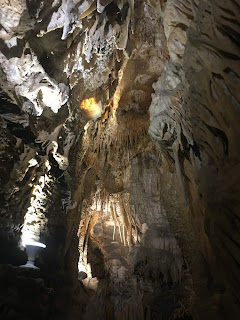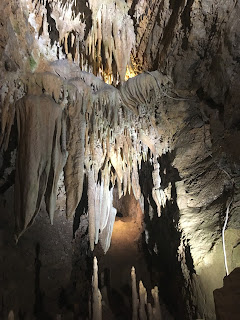 |
| Too Legit to Quit |
After all that, it was back to business as usual with the maintenance division. I worked another day with one of the CCC crews (the very same created by FDR in the New Deal). Except this time the crew was actually here, rather than just me working with the crew leader like I did last time. Myself and two other young men weed whacked (weed eated) a bunch of the culverts along the canal. A culvert is a stone tunnel structure built to allow a stream crossing the path of the canal to flow underneath the towpath and the entire canal itself. When trees grow on the sides of the canal their roots penetrate and weaken the berm walls, including any stone structures like culverts. If they uproot in a storm they can cause a great deal of damage. With a shrinking budget and maintenance department, the culverts of the canal had not been maintained for some time. Last summer the CCC crews removed the trees from all the culverts. This summer they are being weed whacked, and hopefully they will continue to be maintained. The areas that require maintenance are from the towpath down to the top edge of the stone tunnels, usually very steep slopes with as much as a 15 or 20 foot drop to the stream bed below. Its slippery work.
 |
| Caution: Proranger at work |
To compensate for the increased risk of weed whacking the culverts compared to flatter areas, they gave me this sweet helmet/earmuff/face shield piece of protective equipment, as well as a sling for my weed whacker (weed eater).
At the end of the day the crew leader took us up to this viewpoint at the top of a nearby mountain. You can’t see the rest of the turn of the river in this picture, but this is one of the large horseshoe bends in the potomac river in a section called the paw paw bends. Across one of these winding sections of the river is where they built the Paw Paw tunnel that I shared in one of my other blogposts. In a few thousand years (I don’t really know how long it will take) this meander in the river will connect, cutting itself off as the river once again flows in a straight line, leaving behind the stretch of river pictured as an oxbow lake. See that, I learned a few things in my geology course.
| Dale mixes a batch of concrete mortar |
Speaking of culverts, here is one now. The tow path is up above, out of the frame, and the canal bed on the other side. This is Dale, the last remaining mason employed by the canal. One day this week I helped him repair one of the wing walls of this culvert. Its surface was getting degraded, losing stones, so Dale was filling up the holes, replacing the stones, and adding new mortar. This is called repointing. If we are being honest, I didn’t really do much, as Dale is the master mason. I really just helped him carry his materials down into the stream bed and helped spread and smooth the mortar. He already had the project underway before the day I spent with him. It was pretty cool to see how some of the historical preservation is done on the stonework at the canal. Dale talked my ear off all day long, telling me about some of the other restoration projects, what has changed in the park in the 30 plus years he has been here, and just about anything else you can imagine, a few things I probably shouldn’t repeat here.
| Culvert wing wall being repointed |
The top left section of the wing wall, extending out to the right from the tunnel, was already completed. Dale and I worked on the section below. He told me he starts from top to bottom that way each day when he cleans up any mortar that falls down and gets out of place he only has to do it once for that section of wall.





Be First to Comment